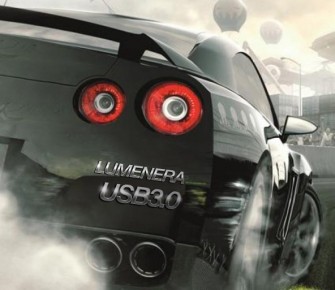Supercars bring an exhilarating level of performance leaving many of us in awe. The high speed, acceleration and handling are all powerful sensations that come to mind. But if you’ve ever driven a supercar, you also quickly notice the lack of visibility, how awkward it can be just getting into the car, or the unforgiving controls that translate even the slightest driver input into a mad rush of power. For these reasons you may be quite happy leaving the supercar at home for your daily commute to work and jumping into your reliable, comfortable, compact car that is user friendly, provides a smoother ride and the gives you the benefit of greater fuel efficiency. Wouldn’t it be amazing if you could enjoy the best of both worlds?
In machine vision, this is what USB 3.0 is all about: the performance of a supercar with the ease-of-use of your compact car. USB 3.0 provides a high-speed data interface (even superspeed), with the ease-of-use of a consumer oriented technology. No need for specialized framegrabbers, exotic cabling or tedious software installation.
USB 3.0 is an evolution of USB 2.0, one of the most popular data interfaces available today. One of USB 3.0’s most compelling features for machine vision systems is its high bandwidth providing a transfer speed of approximately 5 Gb/s, which is ten times faster than USB 2.0 and five times faster than the widely deployed GigE interface. Not all of this is usable speed as USB 3.0 relies on 8b/10b data encoding to embed bus timing information within the data, but even taking this into consideration the effective payload data rate still stands at 4 Gb/s. USB 3.0’s data transfer speed is effectively approaching the speed of specialized machine vision interfaces such as CameraLink and CoaXPress, however, unlike these two interfaces USB 3.0 does not require any special interface cards or framegrabbers in the host computer. USB 3.0 delivers a true plug-and-play experience, largely due to it now being native on today’s computers, as well as finding its way into embedded computers and even tablets. Going hand-in-hand with computing hardware, all major software operating systems have built-in support for USB 3.0.
The advantages offered by USB 3.0 over the specialized machine vision bus technologies makes it so much easier to use. The ubiquity of USB 3.0 ensures the standard has matured to a solid, reliable computer peripheral bus with access to a vast selection of devices. Market research firm NPD Group In-Stat projects that 1 billion USB 3.0 devices will ship in 2014, dwarfing anything seen in strictly machine vision technology. With a wide selection of computer platforms and operating systems, USB 3.0 offers a wide choice of options for system designers, simplifying the implementation of complex machine vision systems.


